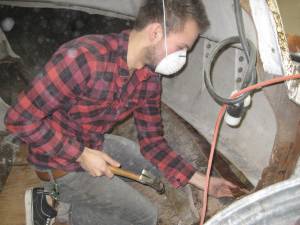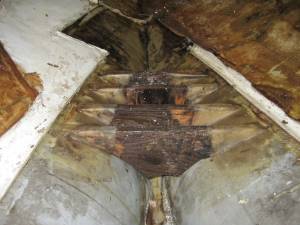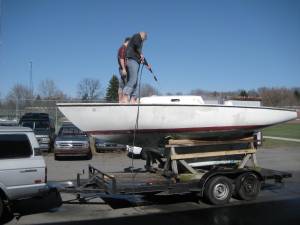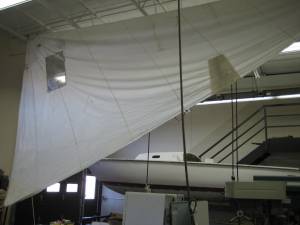Scratch and itch
I think that title may have been used in Don Casey’s “This Old Boat,” but it’s applicable to the work underway on the Ensign. We’ve been grinding, sanding, and grinding some more in preparation for interior reconstruction, and we’re nearly there.
Tony, Nick, Alex S., Bonnie, and Michael D. continued work Friday afternoon. Bonnie settled in with the RO sander and sanded part of the cockpit and bilge. When she’d had enough of the dust, she turned her attention to cleaning the deck hardware – i.e., winches, cleats, etc – in kerosene.
Tony, Nick and Alex cut out the rear bulkhead at the aft end of the cockpit and began removing some more pour-in foam. With limited access, that job is proving to be tough.
Michael D. sounded the decks and circled areas where the core is likely damaged. The starboard sidedeck from the winch base to the chainplates is soggy. The foredeck triangle from the stem fitting aft about 2-1/2 feet is soggy, and the aft deck is shot. We’ve got a fair amount of core replacement to take care of. Typical deck construction consists of a layer of end-grain balsa sandwiched between two layers of fiberglass: the upper skin, which forms the deck, and the lower skin, which forms the bottom of the deck and the interior of the cabin. Repair requires removing the top skin, scraping out all of the damaged (wet) balsa, cleaning the lower skin, then placing new balsa in a bed of epoxy before finally covering it with new fiberglass. Once that’s done, the surface will need to be faired, primed and painted. We’ll postpone deck work until we have the interior bulkheads reinstalled.
I spent some time sanding the interior of the cabin with the RO sander and 80 grit paper to prepare the surfaces for fiberglassing and, eventually, paint.
We ended the day by setting two of the cockpit floors (grate supports) in thickened epoxy. We’ll get an order in for marine-grade plywood and begin reconstructing the cabin on Friday, if all goes as planned.








